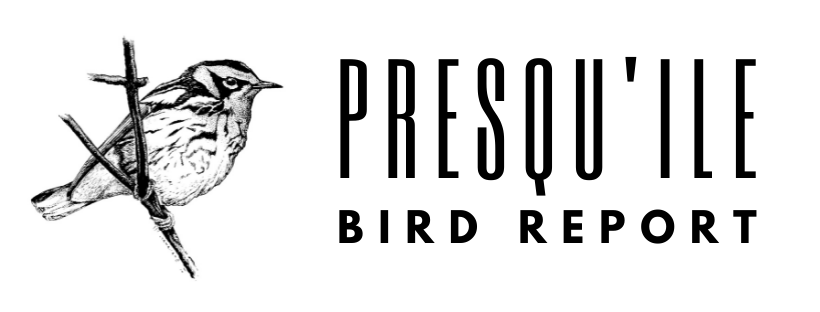
With the summer solstice now behind us, there is a hiatus between the spring and fall bird migrations at Presqu'ile Provincial Park. The focus instead is on birds, mostly water birds, that should be breeding further north, in some cases much further north, but which are appearing in small numbers around the Park.
WOOD DUCKS are the only ducks being regularly (daily) seen in the marsh, most other potential breeding waterfowl having been displaced by the ubiquitous MUTE SWANS. Along the north shore of Gull Island, among the varied dabbling and other ducks, a rare and record late male EURASIAN WIGEON has been present and visible through a scope from lookout #3 on the Owen Point trail for the past two days (June 23/24).
Much of the time it stays hidden on the shore or behind a point of land or among the other ducks, but from time to time it swims out into the open. The GREEN-WINGED TEAL tally in the Owen Point area reached 18 on June 22 and 15 on June 23. REDHEADS and a GREATER SCAUP are also off Gull Island on most days. A RING-NECKED DUCK was reported off the government dock on June 21. A LESSER SCAUP was there on June 23. A male LONG-TAILED DUCK, normally in the Arctic at this time, was in the outer part of Presqu'ile Bay on June 19 and 20. A female COMMON GOLDENEYE has been in Popham Bay for the past three days, and a female HOODED MERGANSER was there yesterday. The pair of RED-BREASTED MERGANSERS that has been at Owen Point for over two weeks was still present today. Another Arctic breeder that should not have been here was a RED-THROATED LOON in full breeding plumage in Popham Bay near Owen Point on June 22.
A canoeing birder flushed a LEAST BITTERN from the outer marsh on June 21. He also heard some unfamiliar grunting emanating from the reeds. A TURKEY VULTURE was spotted in the Park on June 21. Day by day, migrant shorebirds have dwindled to a mere four SEMIPALMATED SANDPIPERS today, whereas earlier in the week there were nine of them plus three SEMIPALMATED PLOVERS, a RUDDY TURNSTONE, and three SANDERLINGS.
Returning LEAST SANDPIPERS might soon appear on the mud flats at Owen Point. BONAPARTE'S GULLS are still being seen daily near the lighthouse, and a GREAT BLACK-BACKED GULL was on the beach on June 20.
A possible FORSTER'S TERN seen this week would be the first this year at Presqu'ile if its identity had been confirmed.
Land birds are notoriously difficult to find these days, especially in the forest, where foliage gets in the way of visual observation and song levels are much reduced from what they were only a month ago. One devoted observer, however, has continued his monitoring of a RED-BELLIED WOODPECKER nest in Jobes' woods. A vocal ALDER FLYCATCHER has been observed on four of the past seven days opposite 38 Bayshore Road.
COMMON RAVEN sightings continue, albeit on a less frequent basis.
Warblers are among the difficult birds to find at this time of year, but it is worth noting that the photographs of a PROTHONOTARY WARBLER taken at the calf pasture on June 3 have been received at the Park office.
ROSE-BREASTED GROSBEAKS are not uncommon in the woods at this time of year, but one birder was fortunate to have one visit his feeder. A PURPLE FINCH came to a different feeder.
To reach Presqu'ile Provincial Park, follow the signs from Brighton.
Locations within the Park are shown on a map at the back of a tabloid that is available at the Park gate. Access to the offshore islands is restricted at this time of year to prevent disturbance to the colonial nesting birds there. Birders are encouraged to record their observations on the bird sightings board provided near the campground office by The Friends of Presqu'ile Park and to fill out a rare bird report for species not listed there.
--
--
Fred Helleiner


